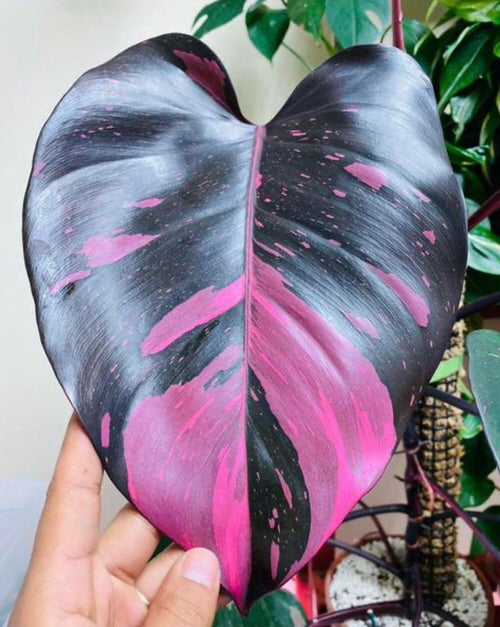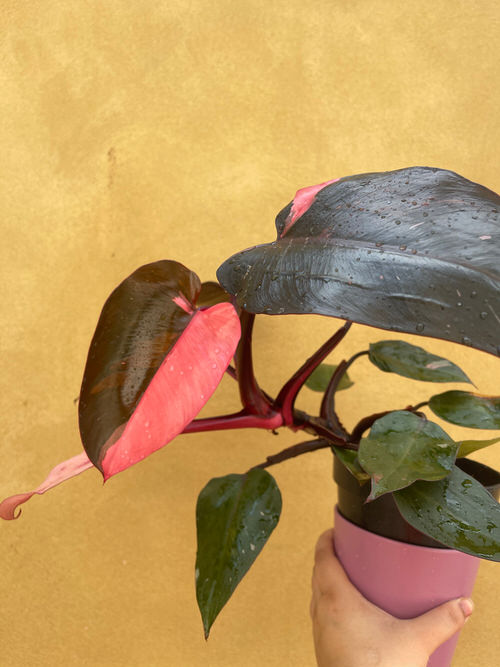Here’s everything about Pink Princess Philodendron Care. If you want a pretty pink houseplant, then this is a perfect pick.

This beautiful pink Philo cultivar is loved for its deep green, heart-shaped foliage with bubblegum pink variegation. If you want to ensure the plant keeps its best color, read this informative article about its perfect care routine.
Botanical Name: Philodendron erubescens ‘Pink Princess’
Note: It is often confused with the Philodendron Pink Congo, but the variegation of ‘Pink Princess Philodendron’ arises naturally while the pink congo’s variegation is temporary–an effect of chemicals injected into the foliage.
Maintain the Color of Your Pink Princess Philodendron

For this variety of philodendron, you need a balanced fusion of green and pink. The green portion is important for photosynthesis. This plant has a habit of sometimes growing either completely pink or greenish leaves. The problem with the completely pink leaves is this reduces the plant’s ability to photosynthesize, whereas entirely dark green leaves don’t look that charming.
To reduce this problem, you’ll have to keep both green and pink variegation in moderation by following this trick below:
If you find more than a couple of new leaves are coming out entirely pink, prune the stems back above the node or leaf joint to encourage new green or variegated growth. Do remember, 2-3 completely pink leaves, along with a few green ones, will do just fine.
Apart from this, to maintain good variegation, here’s one more thing you can do–
Philodendron ‘Pink Princess’ requires plenty of bright filtered light to balance dark green and pink hues. You can also expose it to direct sun but make sure it is never intense mid-day. Also, avoid keeping the plant in a dark spot.
Propagating Pink Princess Philodendron
The simplest way to propagate pink princess philodendron is by stem cuttings:
Snip off 4-6 inches long cuttings from a healthy pink princess philodendron using sanitized scissors. Ensure to take the cuttings right below the leaf node. Dip the end in a rooting hormone and plant the cuttings in a well-draining potting mix.
Water well and place the pot in a greenhouse-like setup or warm spot where it gets bright and indirect light and stable temperature.
The cuttings will form roots in 4-6 weeks, and you’ll be growing a new philodendron pink princess plant. For more details, watch a video here.
Best Pot Size for Growing Pink Princess Philodendron
Start your pink princess philodendron in a 4 or 5 inches pot initially with drainage holes at the bottom. As the plant matures, repot it into a bigger container according to its growth, probably 6 to 8 inches diameter. A mature specimen can be housed in a 12 to 14 inches pot but to determine correctly always pick a planter that is only one or two sizes bigger than the plant’s rootball in order to keep it slightly rootbound.
Requirements for Growing a Pink Princess Philodendron

Location
Choose a location that gets bright, indirect light all day long for healthy growth and variegation. Avoid exposing pink princess philodendron to direct afternoon sun ever, as it can burn the foliage.
In your home, the best place would be a spot close to a window, but if it’s a south or west-facing one, keep the plant slightly away or draw a sheer curtain to provide filtered daylight.
Soil
Use any well-draining growing medium like your regular houseplant mix that you save for pothos and philodendrons; it can be rich in organic matter if you like but avoid using garden soil as it may drain poorly and cause plant diseases.
Water
Being native to the rainforests of South America, the pink princess philodendron loves to stay in slightly moist soil. However, when you grow it indoors and in a pot, this changes!
You should water it thoroughly, but only when the topsoil seems a little dry to the touch. Avoid overwatering as it can lead to root rot, yellow leaves, and wilting.
Temperature
Pink princess philodendron flourishes at average room temperature. The ideal temperature range is around 55-95 F (13-35 C). If you can keep the temperature above 65 F (18 C), it will be great.
Also, protect the plant from cold drafts or direct heat. Do not place the plant near an open window in winter or close to air-conditioning streams.
Support
Adding a moss pole to the pot will help the plant attach its aerial roots to it, helping it grow vertically. As this variety climbs onto trees in its native habitat, mimicking this will make it flourish indoors!
Pink Princess Philodendron Care

Humidity
Like other tropical houseplants, when it comes to pink princess philodendron care, it also requires humidity to look pretty. However, this beautiful houseplant can still grow in a normal dry air room, but if you want it to appear best, take care of the humidity part, as it does best around or above 40%.
You can use a humidifier or put the pot on a tray filled with pebbles and water, but make sure the water level is below the level of pebbles. Grouping houseplants together will also work! To increase humidity, you can follow some other tips shared here.
Fertilizer
Use a balanced, water-soluble fertilizer in half of its recommended strength from February or March, once in three to four weeks. The frequency depends on the amount of light it is receiving. The more light, the more frequently you can fertilize, i.e., 2-3 weeks.
Stop feeding the plant around October if you live in a cold place, as the plant stops growing in the winter and goes into a period of dormancy.
Note: Don’t overfertilize because it is a slow grower.
Re-Potting
Re-pot pink princess philodendron once every 2-3 years, depending on the growth. Use a 2-3 inches bigger pot than the old one with a fresh growing medium. Also, before re-potting, trim the damaged or rotten roots.
Pruning
Snip away yellowing and damaged foliage occasionally, and that’s all you need to keep it looking at the best of its shape.
Pest and Diseases
Pink princess philodendron is vulnerable to aphids, mealybugs, scale, fungus gnats, and spider mites. Use insecticidal soap to take care of them!
To keep potential diseases and fungal issues at bay, avoid overwatering the plant.
Is Pink Princess Philodendron Toxic?
Pink princess philodendron is mildly toxic to pets, according to the American Society for Prevention of Cruelty to Animals (ASPCA). Its sap has calcium oxalate crystals that can cause irritation to the skin or mouth and drooling, if ingested. However, these symptoms subside on their own.


